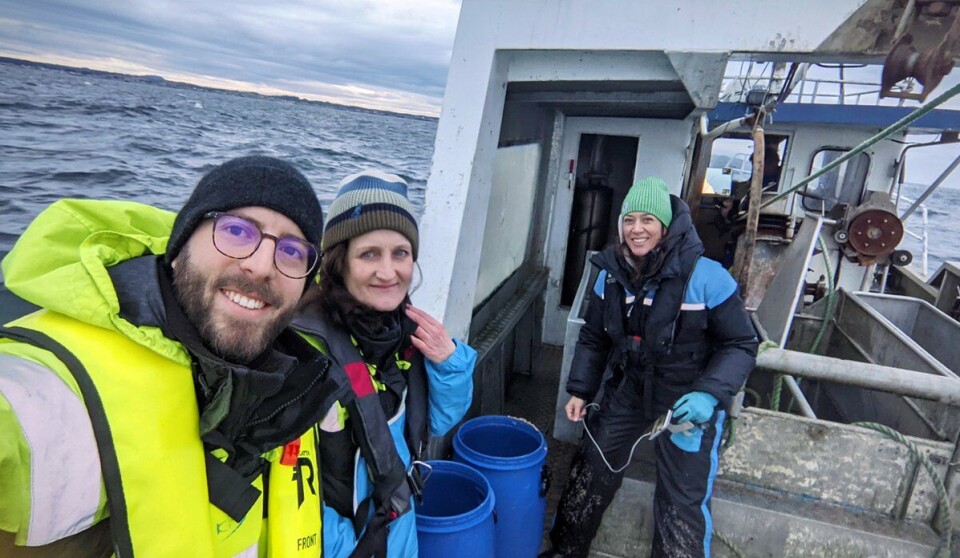THIS ARTICLE/PRESS RELEASE IS PAID FOR AND PRESENTED BY the Institute of Marine Research - read more

Sandeel larvae undisturbed by magnetic fields from subsea cables connecting wind farms
As the offshore wind industry is rapidly expanding, there is concern that magnetic fields produced by subsea cables could affect fish and other marine animals – particularly during their early life stages.
In a new study, scientists at the Institute of Marine Research (IMR) have tried to see if they could find any effects of magnetic fields on the behavior of one particular species: the lesser sandeel (ammodytes marinus).
“The lesser sandeel is a key ecological species of the North Sea and its larvae drift in areas where wind farms have been planned,” explains postdoctoral researcher Alessandro Cresci.
“However, there is no information on possible impacts of magnetic fields from the subsea cables connecting offshore wind farms on sandeel larvae and on marine fish larvae in general.”
Subsea cables produce magnetic fields
Wind farms are connected with each other and to land by a network of subsea cables that transport electricity. Because these cables produce magnetic fields, there is concern that they could harm or disturb the behavior of marine animals, including the vulnerable early life stages of invertebrates and fish.
“With this study, we wanted to understand if magnetic fields produced by subsea cables connecting wind farms would attract or repel sandeel larvae and impact their swimming. Any such effects could have downstream impacts on the survival of this species,” Cresci notes.

Found no evidence of disturbance
To see if they could find any evidence of such effects, scientists set up an experiment where the larvae were exposed to a magnetic field in a realistic setting: the magnetic field intensity was in the range of that produced by subsea cables. Meanwhile, infrared-sensitive cameras recorded the larvae behavior inside a dark raceway tank. The conclusion was clear:
“When exposed to this magnetic field, lesser sandeel larvae were neither attracted nor repelled by them, nor did they change their swimming speed or acceleration,” says Alessandro Cresci.
How was the experiment done? The scientist explains:
“We used a pair of parallel electric coils to induce a gradient of magnetic field intensity in a raceway tank, where larvae were freely swimming. The intensity of the magnetic field produced was in the range of those produced by the subsea cables connecting wind farms. Experiments were conducted in the dark to not provide any cue that larvae could follow other than the magnetic field.”
Other species could be impacted
The study, published in the journal Marine Environmental Research, provides unique data on the potential impacts of subsea cables on the larval stages of an ecologically key species of the North Sea. This is important in the context of planning for areas where offshore wind farms will be installed.
“Although we found no impact of man-made magnetic fields from subsea cables on sandeel, it is possible that these could impact other fish larvae,” Cresci notes.
He explains that some fish species in the North Sea are sensitive to the magnetic field of the Earth and use it for orientation and migration.
“For example, as we have shown in previous research, Atlantic haddock larvae use a magnetic compass to orient at sea during the larval stages. It is possible that these magnetosensitive species could be affected by the subsea cables.”

Larger research agenda
The study forms a part of a larger IMR project, ‘Assessing the effects of offshore wind power generating facilities on the early life stages of fish’. Further studies in this project will examine impacts on larvae of other key species like Atlantic haddock and Atlantic cod. The project is also exploring the impact that operational sound from wind farms has on fish larvae at sea.
The study also contributes toward another research project at IMR focused specifically on lesser sandeel: KnowSandeel.
“KnownSandeel is a co-operation project with the energy industry, which will aim to fill the knowledge gaps related to the sensitivity of sandeel to human activities. This knowledge is important for ecosystem-based management advice related to oil industry, fishery, and wind farming activities,” says project leader Espen Johnsen.
Reference:
Cresci et al. 'Magnetic fields generated by the DC cables of offshore wind farms have no effect on spatial distribution or swimming behavior of lesser sandeel larvae (Ammodytes marinus)', Marine Environmental Research 176, 105609 (2022).
See more content from the Institute of Marine Research:
-
These whales have summer jobs as ocean fertilisers
-
Have researchers found the world’s first bamboo coral reef?
-
Herring suffered collective memory loss and forgot about their spawning ground
-
Researchers found 1,580 different bacteria in Bergen's sewage. They are all resistant to antibiotics
-
For the first time, marine researchers have remotely controlled an unmanned vessel from the control room in Bergen
-
New discovery: Cod can adjust to climate change – from one generation to the next





































